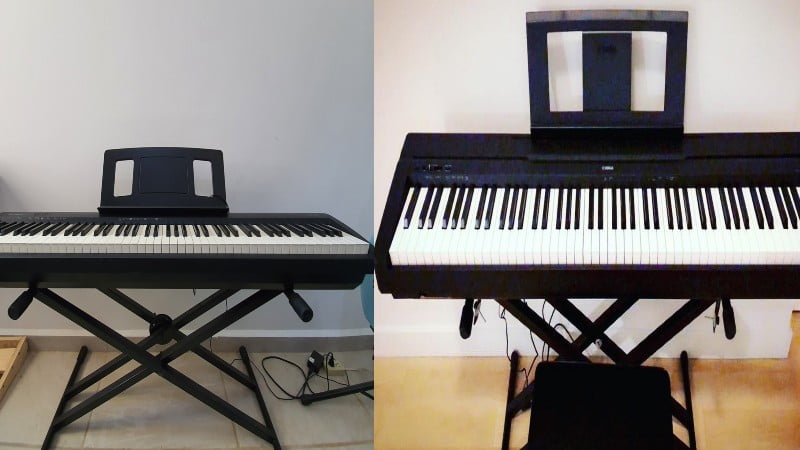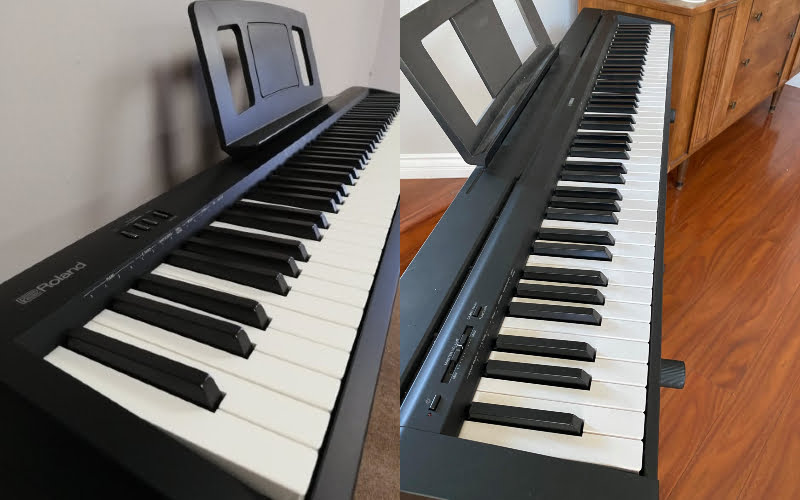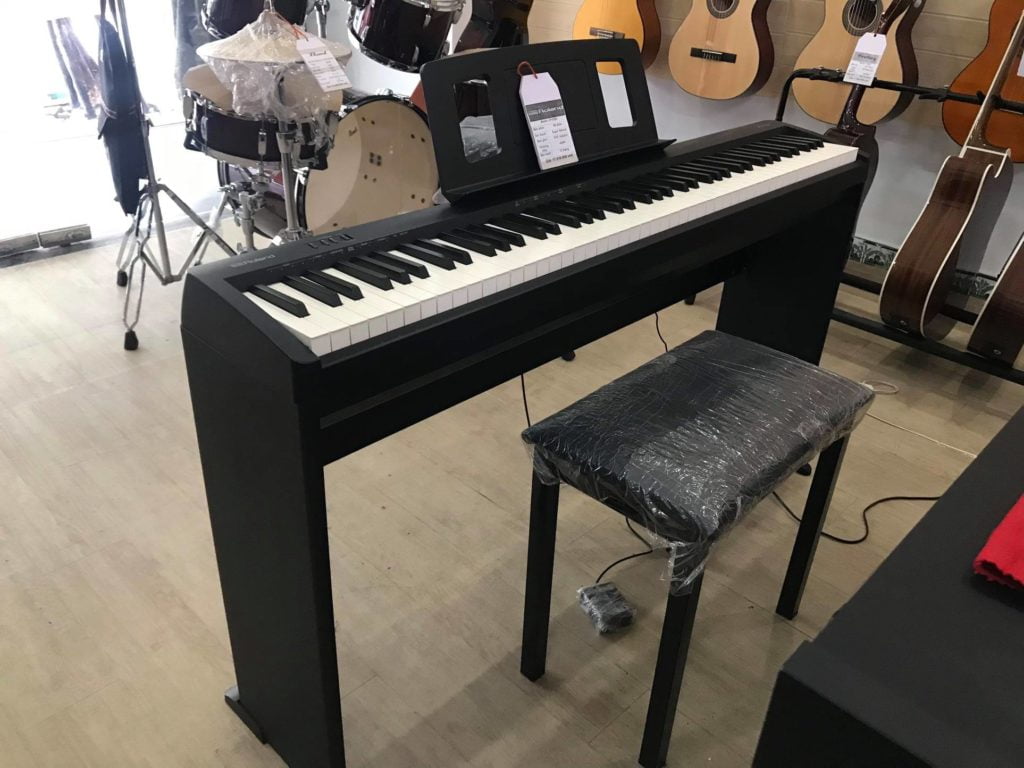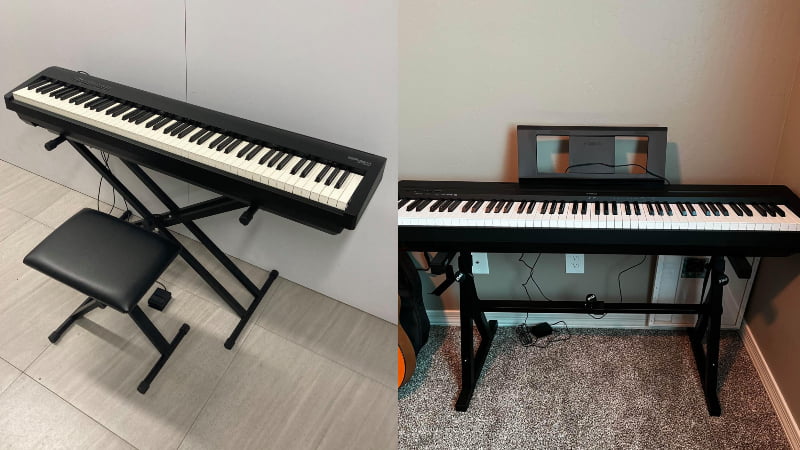After trying out both of these digital pianos, it was honestly tough to choose a winner. They both come with great features that are ideal for any beginner or novice pianist. However, after careful consideration and tons of research, I found that the Roland FP10 is the better option, but not by a lot.
The FP10 features a wide variety of modes and a textured feel on the keys which give it more playability. With the FP10, you get tons of voices and extra features that allow students and beginners to truly explore the instrument.
On the other hand, the Amazon exclusive Yamaha P71 has an incredible tone that’s hard to match in its price range and also offers a couple of cool features and effects that allow you to create beautiful sounds on the piano.
Yamaha P71 vs Roland FP10: Comparison Chart




Last update on 2025-12-27 / Affiliate links / Images from Amazon Product Advertising API
Yamaha P71 vs Roland FP10: Differences
These are two great entry-level digital pianos that are great picks for students. When comparing the two, it was really hard to find a winner as both the Yamaha P71 and Roland FP10 offered great features that rank them at the top of their price range. But after thorough comparisons, I came to the conclusion that the Roland FP10 beats out the Yamaha P71 by 4-2 when comparing their features and differences.
Feel & Playability
The winner: Roland FP10
The reason the FP10 wins in this respect is that it feels closer to an acoustic piano because of the progressive hammer action and textured keys. While the P71 offered decent weighted keys, it just didn’t stack up to those on the FP10.
Hammer Action
The Yamaha P71 is equipped with a fully-weighted, 88-key keyboard. However, this Amazon exclusive doesn’t come with the brand’s signature GHS or Graded Hammer Action system. This is a slight let down, as that means the P71 doesn’t have the same weight of an acoustic piano, especially since this piano has so many other cool features to offer.

The hammer action on the Roland FP10 easily beats out the P71 because it offers progressive hammer action. This means that the keys on the lower end feel heavier, while the higher keys feel lighter, mimicking the feel of an acoustic piano. Additionally, it has an escapement mechanism which recreates the “clicking” feel of when you press halfway down on a grand piano.
So, in terms of hammer action alone, the FP10 easily beats out the P71.
Key Texture
The FP10 has plastic keys just like the P71. However, the difference is that the keys on the FP10 are coated with “Ivory Touch”. This coating absorbs moisture and also mimics the feel of real piano keys, and would be easier to play if you’re used to acoustic pianos.
One of the most common customer complaints with the P71 is that the keys feel like plastic, and that’s because they are. Sadly, these keys aren’t coated with anything to make it feel like an acoustic piano, which is why the FP10 wins over the P71 when comparing the feel and playability of the keys.
Tone
The winner: Tie
Tone is arguably the most important factor of a digital piano, and in the case of these instruments, it’s a tie. One of the reasons I had such a hard time choosing a winner between the two is because their tones were both great for their price range. Both models have a unique tone generation system, a rich sound library, and a host of effects that give the pianist full control over their instrument.
Tone Generation
Both of the pianos generate their tone through samples. Everytime you press a key on these pianos, it triggers a sample or recording, which is how you get the sound. With that said, both pianos use a unique twist on this tone generation method.

The Yamaha P71 uses AWM stereo sampling, which stands for Advanced Wave Memory. This method requires top-quality recording technology to get accurate recordings of different instruments. After recording the sound, a digital filter is applied to the soundwave, which gives it a more realistic and natural sound.
On the other hand, the FP10 uses SuperNATURAL piano sound. This method involves sampling each of the piano’s 88-keys with top of the line equipment, with natural decay. Many other pianos use artificial decay on their samples to save on memory at the cost of sound quality, but that isn’t the case with the FP10.
At the end of the day, the tone generation of both of these pianos is great, especially for its price range. And choosing a winner between the two largely depends on personal preference and the type of sounds the user wants to hear when playing the piano. With that said, Yamaha’s stereo sampling does produce a slightly crisper tone in the ears of most customers, which makes it ideal for those used to acoustic pianos.
Sound Library
Both of these pianos have a fairly small family, with the FP10 only having 15 voices and the P71 having 10. Since the FP10 has a couple more voices than the P71, it has a bit more versatility, but not enough to make a huge difference.
The extra sounds you get on the FP10 are jazz scat, synthpad, and vibraphone, which are all fun and unique voices that any beginner pianist would love to experiment with. With that said, these aren’t exactly common voices that you’ll use in a lot of piano music, which is why I said it doesn’t make a large difference.

Aside from those extra sounds on the FP10, both pianos come with a couple of grand piano, electric piano, and organ voices that you can switch between with the press of a button. While the FP10’s sound library contains more choices, the grand piano sounds from the Yamaha are arguably better, since the samples come from some of Yamaha’s most famous acoustic pianos.
Effects
When it comes to the tone, the effects are probably the only time the Yamaha P71 has an edge. This is because it comes with four types of reverb which can add a lot of realism to the piano’s tone. You can even tweak the reverb to truly reflect your preferences. However, you can’t save your presets for easy access later on, which is a slight hassle.
The FP10 doesn’t come with reverb, but it gives you the ability to adjust the ambience and brilliance of the piano. This is a great way for students to start learning about tweaking piano sounds to fit their preferences. So, while the P71 has a slight edge with its built-in reverb, you still get some tone customization options with the FP10.
Sound System
The winner: Tie
One of the cons of both of these pianos is the sound system. Since they are both designed for students and novice pianists, it doesn’t come with the best sound system. While both pianos come with speakers, they are small, 6W speakers that you can find on either side of the instruments. These speakers are great for practicing, but if you’re jamming with other musicians and performing, you’re going to need to plug into an external sound system.
However, neither of the pianos have dedicated line out ports in the back, so you can only connect to external speakers using the headphone output.
Piano Features
The winner: Roland FP10
When comparing the piano features of each instrument, the Roland FP10 was the winner because of superior polyphony, more connectivity options, and more modes in general that give the pianist more versatility.

Polyphony
Both the FP10 and the P71 have lackluster polyphony, to say the least. In this day and age, most pianos have maximum polyphony over 100, but the FP10 and P71 only have a maximum polyphony of 96 and 64, respectively.
While it isn’t as great as some of the more premium options out there, the FP10’s and P71’s polyphony is good enough to play wide and spread out chords with many notes clearly. However, since the FP10 has a larger polyphony, chords sound slightly clearer than the P71.
Connectivity
One of the areas where the FP10 knocked the P71 out of the park is connectivity. On the FP10, you get wireless MIDI connectivity via bluetooth and wired MIDI via USB. The BlueTooth MIDI is especially useful for beginners as it allows you to pair the device with the Roland app on your phone. From there, you can make adjustments and tweak other parameters. You can also use the Bluetooth to connect wirelessly to a computer and DAW, but customers reported that this works best for Mac users and not PC users.
If you want to use the FP10 as a MIDI controller and play sounds from different VST’s, you can also use the MIDI USB connection. That way, you can use this for practicing as well as recording and composing your own music. The P71 doesn’t have any of these connectivity options, which is why it lags behind the FP10 in this aspect.
Split Mode & Dual Mode
Neither of these models comes with split mode, where you can divide the left and right side of the piano into different sounds, they do come with dual mode. Dual mode allows you to combine the sound of two instruments at the same time. This makes for a very unique tone and allows a lot of room for experimentation, which is a great feature of beginner pianos.
While the FP10 doesn’t have a split mode, you could theoretically divide the left and right side of the piano using the app. On top of that, it comes with twin piano mode, which divides the keyboard into two tiny, 44-key pianos. This is a great feature for piano classes as it allows the student and instructor to play at the same time.
Yamaha P71 vs Roland FP10: The Similarities
These two pianos came with a fair amount of similarities, considering they are some of the best beginner options on the market today. You can’t go wrong with either of these models, as they are both 88-key fully-weighted pianos that are great for beginners and piano students.
Both of these pianos have simple 6W speakers for practicing, which are great for students. However, they won’t be loud enough if you’re playing with other musicians. Additionally, both of the pianos employ a unique spin on simple sampling for tone generation, which allows for a more accurate tone.
If you’re a piano student looking for a quality instrument for practicing, then both the Yamaha P71 and Roland FP10 are great options, though the FP10 offers a very slight edge.
Quick Rundown of the Roland FP10
- Meet the FP-10, the starting point of the acclaimed FP-Series from Roland which has defined how a digital piano should sound and feel.
- Rich, responsive tone from Roland's renowned SuperNATURAL Piano sound engine
- Keys feel like a real acoustic piano, with expressive touch and ivory feel
- Headphones output and quiet keyboard action let you enjoy playing at any time without disturbing others
- Powerful onboard speakers reproduce your playing beautifully
Last update on 2025-12-27 / Affiliate links / Images from Amazon Product Advertising API
Quick Rundown of the Yamaha P71
- Acoustic Piano Feel - Touch-sensitive keys allow for true expression and dynamic performance. The weighted action replicates the acoustic piano experience
- Elevated Sound - Choose from 10 unique Voices, including the richness and resonance of a Yamaha grand piano, with full dynamic sound and deep bass
- Effortless Control - Simple one-button operation and streamlined functionality designed to keep you focused on your music
- Layered Sound - Dual Mode lets you blend two Voices, like piano and strings, creating a rich, layered sound for an inspiring new playing experience
- Included sustain pedal allows for subtle variations and greater expression in your performances
Last update on 2025-12-27 / Affiliate links / Images from Amazon Product Advertising API
Product Video:
Related Articles to Roland Fp10
Related Articles to Yamaha P71
- Alesis Virtue Vs Yamaha P71: Can The Alesis Console Piano Beat Out The Amazon Exclusive?
- Yamaha P71 vs P95: Which Is The Better Digital Piano?
- Yamaha P71 vs Korg B2 Comparison: Battle Of the Two Top Beginner Pianos On the Market
- Yamaha P71 vs Casio CDP-S150: Which Is the Best Beginner Piano On the Market?
- Yamaha P71 vs DGX-660: Can the Amazon Exclusive Beat Out the Premium Model?
- Yamaha P71 vs Donner DEP-20: Which Is the Best Beginner Piano?
- Yamaha P71 vs Casio PX-160 Comparison: Battle of the Two Best Digital Pianos on a Budget
- Yamaha P71 vs Alesis Recital: Why the Amazon Exclusive P71 Is the Best Option for Beginners
- Yamaha P71 vs Alesis Recital Pro: Which Digital Piano is the Best Option for Beginners?
- Yamaha P71 vs P125: Why the Yamaha P125 Is the Better Investment
- Yamaha P71 vs P45: Why the Amazon Exclusive P71 is the Better Digital Piano
References:
Lulacruza is an electronic folk duo operating at the junction of the hypermodern and the ancient. Our music weaves together hypnotic female singing, South American folk instruments and electronic processing, while channeling pulsating waves from the source of creation.
Lalucruza is also a community where you can connect with other music lovers to collaborate, exchange ideas and share knowledge. A platform for who wants to learns the basics of playing piano, guitar, drum masters’ technique, etc.. is the premise of our website.
